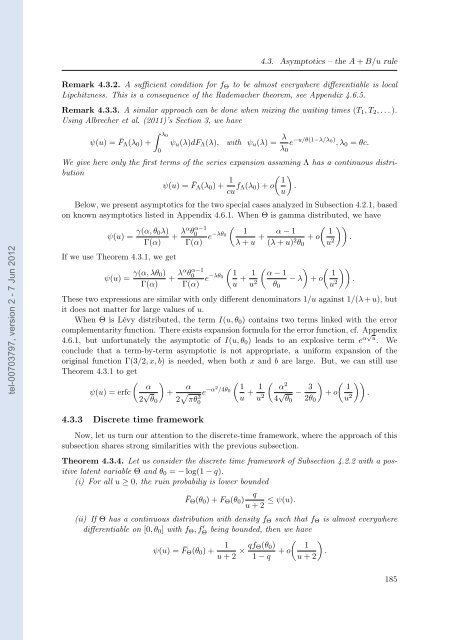Etude des marchés d'assurance non-vie à l'aide d'équilibres de ...
Etude des marchés d'assurance non-vie à l'aide d'équilibres de ...
Etude des marchés d'assurance non-vie à l'aide d'équilibres de ...
You also want an ePaper? Increase the reach of your titles
YUMPU automatically turns print PDFs into web optimized ePapers that Google loves.
tel-00703797, version 2 - 7 Jun 2012<br />
4.3. Asymptotics – the A + B/u rule<br />
Remark 4.3.2. A sufficient condition for fΘ to be almost everywhere differentiable is local<br />
Lipchitzness. This is a consequence of the Ra<strong>de</strong>macher theorem, see Appendix 4.6.5.<br />
Remark 4.3.3. A similar approach can be done when mixing the waiting times (T1, T2, . . . ).<br />
Using Albrecher et al. (2011)’s Section 3, we have<br />
ψ(u) = ¯ FΛ(λ0) +<br />
λ0<br />
0<br />
ψu(λ)dFΛ(λ), with ψu(λ) = λ<br />
e −u/θ(1−λ/λ0)<br />
, λ0 = θc.<br />
We give here only the first terms of the series expansion assuming Λ has a continuous distribution<br />
ψ(u) = ¯ FΛ(λ0) + 1<br />
cu fΛ(λ0)<br />
<br />
1<br />
+ o .<br />
u<br />
Below, we present asymptotics for the two special cases analyzed in Subsection 4.2.1, based<br />
on known asymptotics listed in Appendix 4.6.1. When Θ is gamma distributed, we have<br />
γ(α, θ0λ)<br />
ψ(u) =<br />
Γ(α) + λαθ α−1<br />
0<br />
Γ(α) e−λθ0<br />
<br />
1 α − 1<br />
+<br />
λ + u (λ + u) 2 <br />
1<br />
+ o<br />
θ0 u2 <br />
.<br />
If we use Theorem 4.3.1, we get<br />
γ(α, λθ0)<br />
ψ(u) =<br />
Γ(α) + λαθ α−1<br />
0<br />
Γ(α) e−λθ0<br />
λ0<br />
<br />
1 1<br />
+<br />
u u2 <br />
α − 1<br />
1<br />
− λ + o<br />
θ0<br />
u2 <br />
.<br />
These two expressions are similar with only different <strong>de</strong>nominators 1/u against 1/(λ + u), but<br />
it does not matter for large values of u.<br />
When Θ is Lévy distributed, the term I(u, θ0) contains two terms linked with the error<br />
complementarity function. There exists expansion formula for the error function, cf. Appendix<br />
4.6.1, but unfortunately the asymptotic of I(u, θ0) leads to an explosive term e α√ u . We<br />
conclu<strong>de</strong> that a term-by-term asymptotic is not appropriate, a uniform expansion of the<br />
original function Γ(3/2, x, b) is nee<strong>de</strong>d, when both x and b are large. But, we can still use<br />
Theorem 4.3.1 to get<br />
<br />
α<br />
ψ(u) = erfc<br />
2 √ <br />
+<br />
θ0<br />
α<br />
2 πθ3 0<br />
4.3.3 Discrete time framework<br />
e −α2 /4θ0<br />
<br />
1 1<br />
+<br />
u u2 <br />
α2 4 √ −<br />
θ0<br />
3<br />
<br />
1<br />
+ o<br />
2θ0 u2 <br />
.<br />
Now, let us turn our attention to the discrete-time framework, where the approach of this<br />
subsection shares strong similarities with the previous subsection.<br />
Theorem 4.3.4. Let us consi<strong>de</strong>r the discrete time framework of Subsection 4.2.2 with a positive<br />
latent variable Θ and θ0 = − log(1 − q).<br />
(i) For all u ≥ 0, the ruin probabiliy is lower boun<strong>de</strong>d<br />
¯FΘ(θ0)<br />
q<br />
+ FΘ(θ0) ≤ ψ(u).<br />
u + 2<br />
(ii) If Θ has a continuous distribution with <strong>de</strong>nsity fΘ such that fΘ is almost everywhere<br />
differentiable on [0, θ0] with fΘ, f ′ Θ being boun<strong>de</strong>d, then we have<br />
ψ(u) = ¯ FΘ(θ0) + 1<br />
<br />
qfΘ(θ0) 1<br />
× + o .<br />
u + 2 1 − q u + 2<br />
185
















